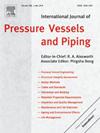Axial compression performance and finite element analysis of coal gangue ceramsite LAC filled PVC tube-steel wire mesh composite columns
IF 3
2区 工程技术
Q2 ENGINEERING, MECHANICAL
International Journal of Pressure Vessels and Piping
Pub Date : 2025-03-06
DOI:10.1016/j.ijpvp.2025.105500
引用次数: 0
Abstract
In the present study, a novel composite column was introduced, which integrates polyvinyl chloride tube and steel wire mesh to confine coal gangue ceramsite concrete (PSCC), aiming to provide a more economical and efficient technical approach for practical engineering applications. The effects of different steel wire mesh layers and concrete strength grades on the axial compressive performance of PSCC has been investigated through experiments and finite element analysis. The findings indicated that the combination of polyvinyl chloride tube and steel wire mesh substantially enhanced the compressive strength and ductility of the concrete columns. Specifically, the peak stress and peak strain of C35 grade concrete confined by 3 layers of steel wire mesh were increased by 177 % and 307 %, respectively. Additionally, the C45 grade concrete confined by 3 layers of steel wire mesh exhibited relatively low rigidity degradation. The finite element analysis confirmed that the developed model accurately simulates the mechanical behavior of PSCC under axial compression. The accuracy of stability coefficient calculation formulas from existing literature and major specifications was evaluated, with the formula proposed in AISC 360-16 showing good agreement with the experimental data from this study. Ultimately, a bearing capacity calculation model was proposed based on experimental and finite element results, with an error margin of less than 5 %.
煤矸石陶粒LAC填充PVC管-钢丝网复合柱轴压性能及有限元分析
本文介绍了一种聚氯乙烯管与钢丝网相结合的新型煤矸石陶粒混凝土约束柱,旨在为实际工程应用提供一种更为经济高效的技术途径。通过试验和有限元分析,研究了不同钢丝网层数和混凝土强度等级对PSCC轴压性能的影响。研究结果表明,聚氯乙烯管与钢丝网的组合可显著提高混凝土柱的抗压强度和延性。其中,3层钢丝网约束下C35级混凝土的峰值应力和峰值应变分别提高了177%和307%。另外,3层钢丝网约束的C45级混凝土的刚度退化程度相对较低。有限元分析表明,所建立的模型能较好地模拟PSCC在轴压作用下的力学行为。对现有文献和主要规范中稳定系数计算公式的准确性进行了评价,AISC 360-16中提出的公式与本研究的实验数据吻合较好。最后,基于试验结果和有限元结果,提出了误差小于5%的承载力计算模型。
本文章由计算机程序翻译,如有差异,请以英文原文为准。
求助全文
约1分钟内获得全文
求助全文
来源期刊
CiteScore
5.30
自引率
13.30%
发文量
208
审稿时长
17 months
期刊介绍:
Pressure vessel engineering technology is of importance in many branches of industry. This journal publishes the latest research results and related information on all its associated aspects, with particular emphasis on the structural integrity assessment, maintenance and life extension of pressurised process engineering plants.
The anticipated coverage of the International Journal of Pressure Vessels and Piping ranges from simple mass-produced pressure vessels to large custom-built vessels and tanks. Pressure vessels technology is a developing field, and contributions on the following topics will therefore be welcome:
• Pressure vessel engineering
• Structural integrity assessment
• Design methods
• Codes and standards
• Fabrication and welding
• Materials properties requirements
• Inspection and quality management
• Maintenance and life extension
• Ageing and environmental effects
• Life management
Of particular importance are papers covering aspects of significant practical application which could lead to major improvements in economy, reliability and useful life. While most accepted papers represent the results of original applied research, critical reviews of topical interest by world-leading experts will also appear from time to time.
International Journal of Pressure Vessels and Piping is indispensable reading for engineering professionals involved in the energy, petrochemicals, process plant, transport, aerospace and related industries; for manufacturers of pressure vessels and ancillary equipment; and for academics pursuing research in these areas.

 求助内容:
求助内容: 应助结果提醒方式:
应助结果提醒方式:


